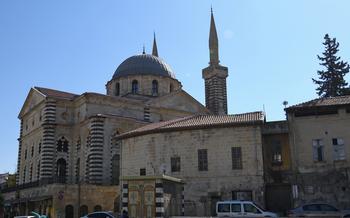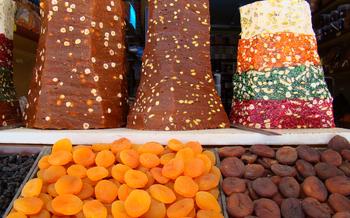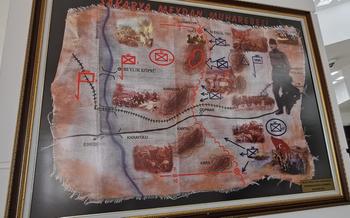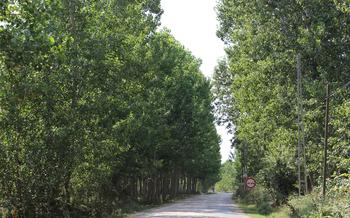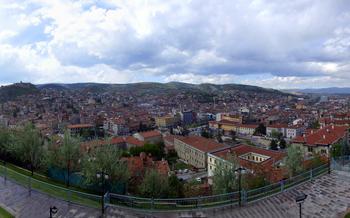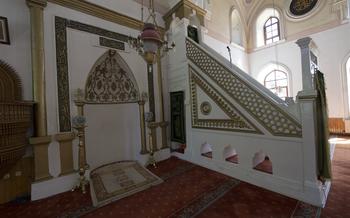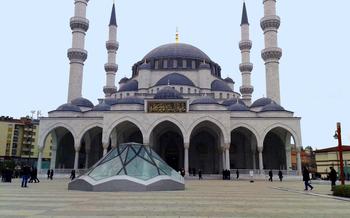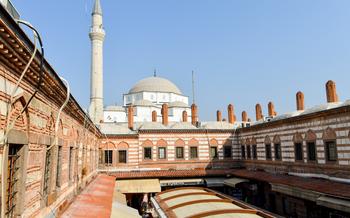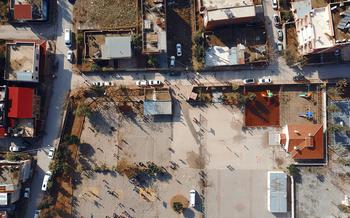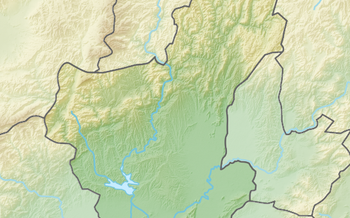
Meydan Camii
- Historical Significance:
- Location
- Architectural Beauty
- Prayer Hall
- Courtyard
- Ablution Fountains
- Madrasa
- Community Center
- Local Cuisine:
- Visitor Etiquette:
- Photography and Videography
- Guided Tours
- Accessibility:
- Insider Tip:
Historical Significance:
The Meydan Camii stands as a testament to Hatay's rich and diverse past. Built in the 16th century during the Ottoman era, this magnificent mosque has witnessed the rise and fall of empires, the ebb and flow of cultures, and the convergence of civilizations. Its strategic location in the heart of Hatay's old city reflects its profound significance as a spiritual and cultural landmark for the region.
The mosque's architectural style is a blend of Ottoman and Seljuk influences, showcasing intricate carvings, elegant domes, and towering minarets. Its unique features, such as the ornate mihrab (prayer niche) and the hand-painted tiles adorning the interior, speak to the exceptional craftsmanship and artistry of its builders.
Throughout the centuries, the Meydan Camii has served as a beacon of faith and a symbol of unity for the people of Hatay. It has played a pivotal role in shaping the religious and cultural traditions of the region, hosting prayers, festivals, and community gatherings that have strengthened the bonds between the diverse communities of Hatay.
Location
The Meydan Camii enjoys a prominent location in the heart of Hatay's old city, a labyrinth of narrow cobblestone streets lined with traditional Ottoman-era architecture. The mosque stands as a beacon of faith and history, beckoning visitors to explore its sacred spaces and immerse themselves in the vibrant tapestry of Hatay's cultural heritage.
Reaching the mosque is a breeze, with various transportation options available. For those arriving by car, there are several parking lots within walking distance. Public transportation is also convenient, with buses and trams stopping nearby.
Once you arrive in the vicinity of the mosque, you'll be greeted by a lively atmosphere, with locals going about their daily lives and tourists exploring the surrounding attractions. Don't miss the opportunity to visit the nearby Hatay Archaeological Museum, home to a fascinating collection of artifacts that shed light on the region's rich past.
Architectural Beauty
The Meydan Camii stands as a testament to the architectural prowess of the region. Its stunning facade showcases intricate carvings and elegant domes that blend seamlessly with the towering minarets, creating a harmonious silhouette against the sky. The mosque's design is a testament to the fusion of Islamic and local architectural styles, resulting in a unique masterpiece that leaves visitors in awe.
The Meydan Camii incorporates elements of traditional Islamic architecture, such as the use of arches and domes, while also incorporating local influences in its decorative details. The exterior is adorned with intricate carvings that depict verses from the Quran, geometric patterns, and floral motifs. These intricate embellishments add a touch of grandeur to the mosque's facade, making it a sight to behold.
Throughout the years, the Meydan Camii has undergone several renovations and restorations, each contributing to its unique character. These renovations have preserved the mosque's original architectural features while also adding modern touches that enhance its functionality. The result is a mosque that seamlessly blends the past and present, creating a harmonious space for worship and contemplation.
Prayer Hall
The prayer hall of the Meydan Camii is a sight to behold, exuding an atmosphere of serenity and grandeur that invites contemplation and devotion. As you step inside, your gaze is drawn to the intricate patterns and calligraphy that adorn the walls and ceiling, creating a mesmerizing visual tapestry. The vast space is divided into distinct sections, each designated for men and women, ensuring privacy and fostering a sense of community.
Rows of plush carpets cover the floor, inviting worshippers to sink into comfort as they engage in their prayers. The mihrab, or prayer niche, occupies a central position, indicating the direction of Mecca and serving as a focal point for the faithful. Its design is particularly striking, featuring intricate carvings and colorful tiles that evoke a sense of awe and reverence.
The soft glow of natural light filtering through the stained-glass windows casts a warm and ethereal ambiance throughout the prayer hall. The acoustics are impeccable, allowing the melodious recitation of the Quran and the collective prayers to reverberate harmoniously, creating a truly immersive spiritual experience.
I recall my first visit to the Meydan Camii during the holy month of Ramadan. The atmosphere was electric, with worshippers from all walks of life gathering to perform Taraweeh prayers. The recitation of the Quran by the imam was mesmerizing, and the collective supplications echoed through the hall, creating a profound sense of unity and devotion.
Courtyard
The charming courtyard of the Meydan Camii is an oasis of tranquility and contemplation amidst the bustling city. The serene atmosphere invites visitors to pause and reflect, surrounded by the mosque's architectural wonders. The courtyard features beautiful fountains, elegant columns, and lush gardens, creating a harmonious blend of nature and Islamic art.
The fountains, with their gentle flow of water, add a soothing ambiance to the courtyard. Ablution fountains, used for ritual washing before prayer, line one side of the courtyard, providing a practical and spiritual function. The columns, with their intricate carvings and delicate arches, offer a glimpse into the mosque's rich history and architectural legacy.
The gardens, with their colorful flowers and fragrant plants, bring a touch of life and vibrancy to the courtyard. Visitors can stroll along the pathways, admiring the beauty of the blooming roses, the delicate jasmine flowers, and the aromatic herbs that fill the air with their sweet scents.
The courtyard also serves as a gathering place for community events and celebrations. During religious festivals, the courtyard transforms into a vibrant space filled with music, laughter, and shared joy. Locals gather to celebrate, exchange greetings, and strengthen their bonds of community.
Whether seeking a moment of solitude or a chance to connect with the local community, the courtyard of the Meydan Camii offers a unique and enriching experience for visitors. Its tranquil ambiance, architectural beauty, and social significance make it a must-visit destination in Hatay.
Ablution Fountains
The courtyard of the Meydan Camii features a series of elegant ablution fountains, where worshippers perform the ritual washing before prayer. These fountains, with their intricate designs and sparkling water, create a serene and purifying ambiance. The act of ablution holds deep significance in Islamic tradition, symbolizing both physical and spiritual cleanliness. As water flows from the fountains, it echoes the teachings of purity and devotion that permeate the mosque's atmosphere.
Visitors can observe the graceful movements of worshippers as they engage in this sacred ritual. The ablution fountains serve as a reminder of the importance of cleanliness and the connection between the physical and spiritual realms in Islamic practice. The gentle sound of water and the hushed conversations among worshippers create a sense of tranquility, inviting visitors to reflect on the deeper meanings behind this essential Islamic tradition.
Madrasa
Within the Meydan Camii complex, visitors can discover a madrasa, a traditional Islamic school dedicated to religious and secular education. Madrasas have played a crucial role in the history of Hatay, serving as centers of learning and scholarship. In the past, students from various regions flocked to these institutions to study a wide range of subjects, including Islamic law, theology, literature, mathematics, and astronomy.
The madrasa at the Meydan Camii is a testament to the region's rich educational heritage. Its classrooms, libraries, and dormitories once bustled with the energy of young scholars seeking knowledge and enlightenment. The curriculum was comprehensive, encompassing both religious and worldly disciplines, reflecting the holistic approach to education that characterized Islamic civilization.
Today, the madrasa may no longer function as an active school, but its legacy lives on in the intellectual and cultural fabric of Hatay. Visitors can explore the madrasa's well-preserved architecture, admire its intricate carvings and calligraphy, and imagine the vibrant atmosphere that once filled its halls.
Community Center
The Meydan Camii is not only a place of worship but also a vibrant community center that fosters social and cultural interactions. The mosque complex encompasses various spaces that serve as venues for diverse events and gatherings. Within its walls, the community comes together to celebrate religious festivals, organize workshops, hold lectures, and conduct educational programs.
One of the most notable events held at the mosque is the annual Hatay Cuisine Festival, which showcases the region's rich culinary heritage. Visitors can indulge in a delectable array of traditional dishes, prepared with fresh local ingredients and centuries-old recipes. The festival provides a platform for local cooks and chefs to share their culinary expertise and promote Hatay's gastronomic traditions.
The mosque also hosts regular lectures and workshops on various topics, ranging from Islamic history and theology to contemporary social issues. These events provide a forum for intellectual discourse, cultural exchange, and community engagement. Visitors can learn from renowned scholars, experts, and community leaders, fostering a sense of intellectual curiosity and growth.
Furthermore, the Meydan Camii serves as a gathering place for various community celebrations, such as weddings, circumcision ceremonies, and religious holidays. These events bring together families, friends, and neighbors to share in moments of joy and festivity. The mosque's spacious courtyard and prayer hall provide an ideal setting for these celebrations, creating a sense of unity and belonging within the community.
Local Cuisine:
Hatay's culinary scene is a symphony of flavors, aromas, and textures that will tantalize your taste buds. As you explore the vicinity of the Meydan Camii, immerse yourself in the culinary delights that this region is renowned for. Indulge in the famous künefe, a crispy shredded phyllo pastry filled with sweet cheese and topped with syrup, a true testament to Hatay's culinary prowess. For a savory treat, savor the delectable taste of tepsi kebab, a traditional dish featuring tender lamb or beef cooked with vegetables in a clay pot. Don't miss the opportunity to try freshly baked gözleme, a savory flatbread filled with your choice of ingredients, cooked to perfection on a saj. As you explore the narrow streets surrounding the mosque, you'll find an array of local eateries and food stalls, each offering unique culinary treasures. Whether you prefer to dine in a traditional restaurant or grab a quick bite on the go, Hatay's cuisine will leave you with unforgettable memories.
Visitor Etiquette:
When visiting the Meydan Camii, it is essential to adhere to the local customs and courtesies to ensure a respectful and harmonious experience. Modest dress is highly recommended, covering shoulders and knees for both men and women. Visitors should avoid wearing shorts, tank tops, or revealing clothing. Upon entering the mosque, it is customary to remove shoes and place them neatly on the designated shelves. Maintaining silence and minimizing distractions during prayer times is crucial. Visitors should avoid talking loudly, taking phone calls, or engaging in activities that may disrupt the spiritual atmosphere. It is considered polite to greet the mosque officials or other visitors with a friendly "Merhaba" (Hello) or "As-salamu alaykum" (Peace be upon you). Photography and videography are permitted in most areas of the mosque, but it is important to be mindful of the privacy of other visitors and avoid using flash or disturbing others.
Photography and Videography
Photography and videography within the Meydan Camii are generally allowed for personal use, provided that visitors respect the sanctity of the mosque and the privacy of worshippers. However, it is important to adhere to certain guidelines to ensure that your actions do not disturb or disrupt religious activities. Flash photography and the use of tripods or selfie sticks are not permitted, as they can be disruptive during prayer times. It is also important to refrain from taking photographs or videos of individuals without their consent. When in doubt, it is best to seek permission from the mosque officials or a knowledgeable guide to avoid any misunderstandings. By following these guidelines, you can capture beautiful memories of your visit while respecting the spiritual significance of the Meydan Camii.
Guided Tours
If you seek a more in-depth understanding of the Meydan Camii and Hatay's rich history, consider joining a guided tour. Knowledgeable local experts lead these tours, providing insights into the mosque's architecture, history, and cultural significance. You'll learn about the Meydan Camii's role in the community, its architectural influences, and the stories behind its construction and restoration.
Guided tours typically cover other historical sites in Hatay, allowing you to explore the city's rich heritage comprehensively. They often include visits to ancient ruins, churches, and museums, providing a well-rounded perspective of Hatay's diverse past.
To book a guided tour, you can contact local tour operators or inquire at your hotel's concierge. Prices vary depending on the tour's duration, group size, and the number of sites visited. Guided tours offer an enriching experience, allowing you to delve deeper into Hatay's history and culture.
Accessibility:
The Meydan Camii is committed to ensuring inclusivity and accessibility for all visitors, regardless of their physical abilities. The mosque complex is equipped with ramps and elevators, allowing wheelchair users and individuals with limited mobility to navigate the premises with ease. Accessible restrooms are also available within the mosque complex.
For those with visual impairments, the mosque provides tactile maps and braille signage to assist in wayfinding. Additionally, trained staff members are available to offer guidance and support to visitors with disabilities, ensuring a comfortable and enriching experience for everyone.
To further enhance accessibility, the mosque offers sign language interpretation services upon request. Visitors who require this service should make a prior arrangement with the mosque administration to ensure availability.
By embracing inclusivity and providing accessible features, the Meydan Camii welcomes all visitors to experience the spiritual and cultural significance of this historic landmark.
Insider Tip:
For an unforgettable experience, plan your visit to the Meydan Camii during the early morning hours. As the sun casts its golden rays upon the mosque's exterior, the intricate carvings and architectural details come alive, creating a mesmerizing spectacle. The tranquility of the courtyard, coupled with the melodious sound of birdsong, provides a serene atmosphere that invites contemplation and introspection. Take this opportunity to soak in the beauty of the mosque and connect with its spiritual essence.
